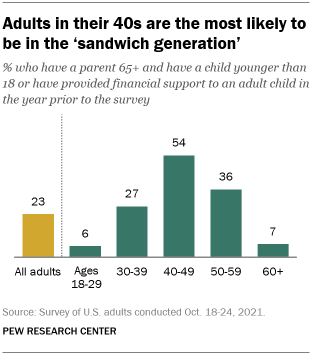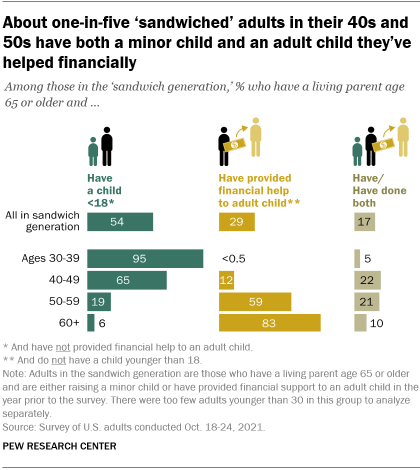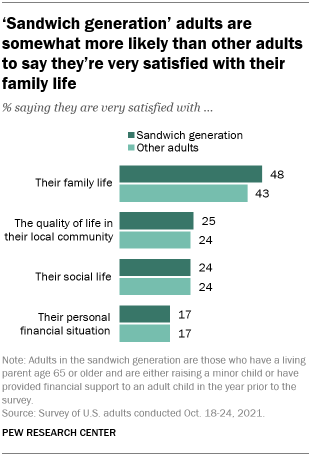
As people are living longer and many young adults are struggling to gain financial independence, about a quarter of U.S. adults (23%) are now part of the so-called “sandwich generation,” according to a Pew Research Center survey conducted in October 2021. These are adults who have a parent age 65 or older and are either raising at least one child younger than 18 or providing financial support to an adult child.

Americans in their 40s are the most likely to be sandwiched between their children and an aging parent. More than half in this age group (54%) have a living parent age 65 or older and are either raising a child younger than 18 or have an adult child they helped financially in the past year. By comparison, 36% of those in their 50s, 27% of those in their 30s, and fewer than one-in-ten of those younger than 30 (6%) or 60 and older (7%) are in this situation.
Men and women, as well as adults across racial and ethnic groups, are about equally likely to be in the sandwich generation, but there are some differences by educational attainment, income and marital status. About a third of married adults (32%) are in the sandwich generation, compared with 23% of those who are divorced or separated, 20% of those who are living with a partner, and just 7% each of those who are widowed or have never been married.
To assess the share of U.S. adults who are in the sandwich generation, that is, who have an aging parent age 65 or older and are raising children younger than 18 or providing financial support to adult children, the Center surveyed 9,676 U.S. adults during the period of Oct. 18-24, 2021. Everyone who took part is a member of Pew Research Center’s American Trends Panel (ATP), an online survey panel that is recruited through national, random sampling of residential addresses. This way nearly all U.S. adults have a chance of selection. The survey is weighted to be representative of the U.S. adult population by gender, race, ethnicity, partisan affiliation, education and other categories. Read more about the ATP’s methodology.
Here are the questions used for the report, along with responses, and its methodology.
Adults with at least a bachelor’s degree (30%) are more likely than those with some college or less education (20%) to be in the sandwich generation. And while 27% of those with upper incomes are sandwiched between an aging parent and their own children, a smaller share of those with lower incomes (21%) are in this situation. About a quarter of adults with middle incomes (24%) are part of the sandwich generation.

The family circumstances of sandwiched adults vary considerably by age. In their 30s and 40s, most have an aging parent and at least one child younger than 18, but no adult children they’ve supported financially. This is the case for nearly all sandwiched adults in their 30s (95%) and 65% of those in their 40s.
By the time they’re in their 50s, far smaller shares of sandwiched adults are raising children who are minors. Instead, a majority of those in their 50s (59%) and those 60 and older (83%) are sandwiched between an aging parent and an adult child they’ve helped financially.
Among those in their 40s and 50s, the two age groups most likely to be in the sandwich generation, about one-in-five have both a child younger than 18 and an adult child they’ve helped financially, in addition to having an aging parent. There aren’t enough sandwiched adults younger than 30 to analyze separately.
Adults who are sandwiched between an aging parent and a minor child or an adult child they’ve helped financially are more likely than those who are not in this situation to say they are very satisfied with their family life (48% vs. 43%, respectively). This difference is particularly pronounced among those in their 40s: About half of sandwiched adults in this age group (49%) say they are very satisfied with their family life, compared with 38% of other adults in the same age group.

When it comes to assessments of some other aspects of life, adults who are and are not sandwiched give similar answers. About a quarter in each group say they are very satisfied with their social life and with the quality of life in their local community, and 17% in each express high levels of satisfaction with their personal financial situation.
Adults who are sandwiched between an aging parent and their own children are about as likely as other adults to live in a multigenerational household, though they may not be living with the family members they are sandwiched between. About one-in-five in each group live with multiple adult generations under the same roof (19% of those in the sandwich generation vs. 18% of other adults).
A Pew Research Center survey conducted in 2014 also found that 23% of U.S. adults were in the sandwich generation. However, the 2014 survey was conducted by phone rather than the Center’s online American Trends Panel, so these results aren’t directly comparable.
Note: Here are the questions used for the report, along with responses, and its methodology.
